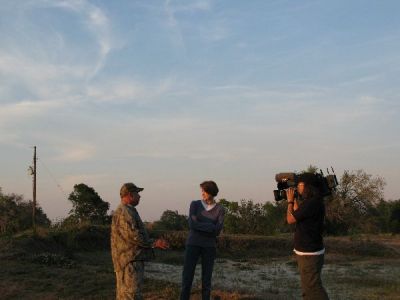.
Trapper John,
Wild Boar Trapping Expert
Rooting
Feral pigs, wild boars, Sus Scrofa, Russian boars, whatever you call them, they can make a mess out of your property very quickly by rooting. Wild pigs will eat just about anything; leaves, seeds, roots, small animals, insects, and even carrion. These animals can forage alone or in family groups of up to 20 individuals. They love acorns and fruit. The reproduction rate of the pigs is tied to their food supply. Sadly oftimes your yard, like the land pictured to the left, is torn up by their eating habits. The damage shown was done overnight in a New Orleans subdivision by a small family unit of pigs numbering from five to eight individuals. Some rooting holes can be as much as three feet deep.
Wild boars are most active in the morning and afternoon, but will shift to dusk or night feeding depending on how threatened they feel. Sometimes the animals will learn to avoid traps and other methods of capture, such as snares, are introduced. When they feel threatened they can also leave the area looking for safer feeding and can range an average of thirty miles a day and are strong swimmers.
.
Feral pigs are not easily confused with domestic pigs. They are medium-sized hoofed mammals with a long, pointed head and stocky build. Males and females look much alike. Wild boars exhibit great variation in color and size. The average wild sow weighs about 110 pounds, ranging from 77 to 330 pounds, and the average wild boar weighs from 130 to 440 pounds. Unusually large feral pigs have been taken that reach three feet tall, six feet long and over 500 pounds. Their hair is coarse with long bristles; coarser, denser and longer than that of a domestic pig. Colors and patterns range from solid black, gray, brown, blonde, white, or red to spotted and belted combinations of these same colors. Most generally, however, the animals are black. An adult develops a thick, scruffy mane with stiff bristles tipped with blonde.
Wild pigs have elongated, flexible, tough, flattened snouts and their pointed ears, four to five inches long, stand erect in most cases. Their tails are never coiled like a domesticated animals but are long and lightly covered in hair. Boars grow tusks which can be up to eight or nine inches long. Many times they're worn down or broken. These never stop growing for the life of the animal.

.

Traps are most commonly employed to capture wild pigs. They are humane, unlike leghold traps, and allow the animal to be captured unharmed. Some of the more aggressive boars will attempt to attack anyone coming near the cage. These hogs are intelligent, as smart, if not smarter than most dogs.
.
Trapper John was interviewed on CNN by Susan Roesgen for a spot that first aired on May 19th, 2007. You can watch the video by clicking on the photo to the right or here.
.
Trapper John and one of his assistants carefully set a trap near an area recently rooted by a herd of wild boar in Southeast Louisiana.

